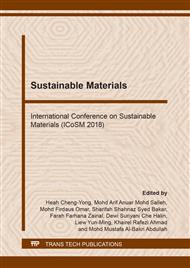p.102
p.109
p.115
p.121
p.127
p.134
p.142
p.151
p.157
Structure and Electrical Characteristics of BaTiO3 and Ba0.99Er0.01TiO3 Ceramics
Abstract:
Conventional solid state reaction method was used to prepare BaTiO3 and Ba0.99Er0.01TiO3 ceramics. Influence of Er3+ ion incorporation on their structural, microstructural and electrical properties was studied. The phase pure samples were obtained when heated at 1400 °C for overnight. The tetragonal perovskite phase of BaTiO3 and Ba0.99Er0.01TiO3 was confirmed by using X-ray Diffraction (XRD) analysis which is in agreement with results obtained from Rietveld refinement analysis. The lattice parameters and unit cell volume of BaTiO3 increased when doped with Erbium. Microstructural analysis of BaTiO3 and Ba0.99Er0.01TiO3 ceramics showed that the grain sizes of BaTiO3 and Ba0.99Er0.01TiO3 significantly decreased. The dielectric properties of BaTiO3 and Ba0.99Er0.01TiO3 were investigated as a function of temperature and frequency. It revealed that the Curie temperature (TC) increased by doping Er content from 110 °C to 120 °C. Ba0.99Er0.01TiO3 exhibited the high value of dielectric constant (ε=5929) at TC of 120 °C. The capacitance-voltage characteristic revealed that the voltage breakdown for both BaTiO3 and Ba0.99Er0.01TiO3 exceeded 30 V.
Info:
Periodical:
Pages:
127-133
Citation:
Online since:
August 2018
Price:
Сopyright:
© 2018 Trans Tech Publications Ltd. All Rights Reserved
Share:
Citation:


